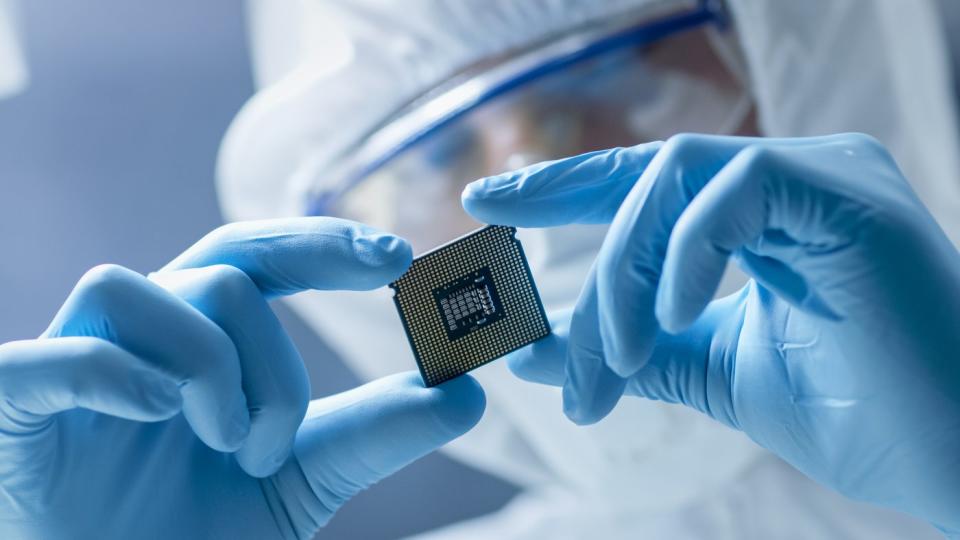This coming Sunday, May 26, will mark the 128th “birthday” for Wall Street’s most iconic stock index, the Dow Jones Industrial Average (DJINDICES: ^DJI).
When the Dow was first introduced in 1896, it was comprised of 12 predominantly industrial companies. Today, it’s a mix of 30 time-tested, multinational businesses from an assortment of sectors and industries.
While the Dow Jones has historically been viewed as a home for mature businesses that deliver modest growth and a quarterly dividend, ongoing changes to the index have shifted its representation. Though some of its components absolutely fit the bill as predictable, low-volatility businesses with market-topping yields (e.g., Coca-Cola, Johnson & Johnson, and Procter & Gamble), growth stocks are now also a notable part of this ageless index.
In particular, companies involved in the rise of artificial intelligence (AI) are represented within the Dow.

The Dow Jones is home to companies benefiting from the artificial intelligence revolution
In its simplest form, AI relates to software and systems handling tasks that would normally be overseen by humans. What gives AI such wide-ranging utility is the ability for these systems to learn and evolve over time without human intervention (what’s known as “machine learning”). Software and systems becoming more proficient at their tasks, and perhaps even learning new skills or tasks, suggests AI can alter the growth trajectory for nearly every sector and industry.
According to analysts at PwC, artificial intelligence can add a jaw-dropping $15.7 trillion to the global economy by the turn of the decade. PwC estimates that $6.6 trillion of this benefit will come from increased productivity, with the remaining $9.1 trillion traced to various consumption-side effects.
Wall Street’s smartest, most-successful money managers don’t want to miss out on this trend — and the latest round of Form 13F filings with the Securities and Exchange Commission (SEC) shows it.
A 13F is a required quarterly filing for institutions with at least $100 million in assets under management that gives investors under-the-hood access to what Wall Street’s top investors bought and sold in the latest quarter. The 13Fs filed with the SEC on May 15 (the last day to report trades made in the March-ended quarter) show that prominent billionaire investors have been buying two AI Dow stocks hand over fist since 2024 began.
Amazon
The first artificial intelligence stock billionaire money managers can’t stop buying is a company that was added to the Dow Jones Industrial Average in February. I’m talking about world-leading e-commerce company Amazon (NASDAQ: AMZN). During the first quarter, nine billionaires purchased shares, including (total shares purchased in parentheses):
-
Israel Englander of Millennium Management (2,390,755 shares)
-
Ole Andreas Halvorsen of Viking Global Investors (1,972,702 shares)
-
Chase Coleman of Tiger Global Management (1,438,600 shares)
-
Jeff Yass of Susquehanna International (1,336,042 shares)
-
Ray Dalio of Bridgewater Associates (1,047,891 shares)
-
Dan Loeb of Third Point (900,000 shares)
-
Ken Fisher of Fisher Asset Management (785,018 shares)
-
Ken Griffin of Citadel Advisors (352,453 shares)
-
Philippe Laffont of Coatue Management (241,514 shares)
Amazon is using AI in more ways than I can list. Some of the more prominent examples include AI being deployed to improve search functionality for its online marketplace, as well as generative AI solutions being leaned on by Amazon Web Services (AWS) customers to tailor their message(s) to consumers.
Most people are familiar with Amazon because of its dominant e-commerce platform. Last year, Amazon accounted for nearly 38% of U.S. online retail sales. But in spite of all the revenue it brings in from its online marketplace, e-commerce provides Amazon little in the way of operating cash flow or income.
Amazon’s bread-and-butter operating segments are AWS, subscription services, and advertising services.
A strong argument can be made that nothing is more important to Amazon’s success than the continued growth of AWS. Enterprise cloud spending is still fairly early in its ramp-up stage, and as of the March-ended quarter, AWS had surpassed $100 billion in annual run-rate sales. Since cloud-service margins are substantially higher than what’s generated from online retail sales, AWS is typically responsible for more than half of Amazon’s operating income each year.
Subscription services is another rapidly growing segment for the company. In April 2021, then-CEO Jeff Bezos announced that Amazon had surpassed 200 million global Prime subscribers. Not only has this figure likely risen since the company secured the exclusive rights to Thursday Night Football, but perks that include free two-day shipping and access to the company’s content library make it easy for Amazon to raise Prime subscription prices.
Lastly, Amazon’s advertising services segment hasn’t delivered a quarter of less than 20% sales growth in over two years. It’s easy to maintain strong ad-pricing power when you draw more than 2 billion people to your site each month.


Intel
The second AI Dow stock that billionaire investors have been buying hand over fist since the beginning of the year is semiconductor juggernaut Intel (NASDAQ: INTC). Intel was added to the Dow back in November 1999.
During the first quarter, six top-tier billionaires purchased shares of Intel — seven, if you include the recently passed Jim Simons of Renaissance Technologies — including (total shares purchased in parentheses):
-
Jeff Yass of Susquehanna International (4,836,516 shares)
-
Ken Griffin of Citadel Advisors (1,757,626 shares)
-
John Overdeck and David Siegel of Two Sigma Investments (1,345,269 shares)
-
Israel Englander of Millennium Management (413,507 shares)
-
Ray Dalio of Bridgewater Associates (411,473 shares)
Although Intel is best known for its legacy hardware, such as central processing units (CPUs) used in personal computers (PCs), it’s a company that very much has AI at the forefront of its growth strategy. For instance, Intel has been incorporating AI optimizations into its advanced developer tools, such as oneAPI and its deep-learning OpenVINO toolkit, to help clients using its hardware build, optimize, and deploy their AI solutions.
Intel is also rolling out its Gaudi3 AI accelerator this year. Gaudi3 is a graphics processing unit (GPU) designed to go head-to-head with the current infrastructure backbone of the AI revolution, Nvidia. AI-GPUs are effectively the “brains” that allow for rapid computation in AI-accelerated data centers, and there’s been a big-time shortage of these chips for more than a year.
Beyond its AI ambitions, billionaires might be attracted to Intel as a bounce-back candidate following a couple of years of weakness in PC sales. Despite losing some of its CPU market share in PCs and data centers to chief rival Advanced Micro Devices, Intel still holds the bulk of CPU market share in these categories. While these may not be rapidly growing segments anymore, they deliver abundant operating cash flow that Intel can repurpose in higher-growth initiatives.
Aside from AI, one of these “higher-growth initiatives” is its Foundry Services segment. Building its foundry operations from the ground up to mass production is a costly procedure that’s currently weighing on Intel’s bottom line. But by the end of the decade, new chip fabrication facilities in Ohio and Germany have the potential to lift Intel to No. 2 in global foundry services share.
Lastly, Intel’s valuation may be compelling to billionaires. Wall Street’s consensus calls for Intel to more than triple its earnings per share (EPS) from a reported $1.05 in 2023 to an estimated $3.47 by 2027. When coupled with an S&P 500-topping yield of 1.6%, Intel has a value proposition to offer its patient investors.
Should you invest $1,000 in Amazon right now?
Before you buy stock in Amazon, consider this:
The Motley Fool Stock Advisor analyst team just identified what they believe are the 10 best stocks for investors to buy now… and Amazon wasn’t one of them. The 10 stocks that made the cut could produce monster returns in the coming years.
Consider when Nvidia made this list on April 15, 2005… if you invested $1,000 at the time of our recommendation, you’d have $581,764!*
Stock Advisor provides investors with an easy-to-follow blueprint for success, including guidance on building a portfolio, regular updates from analysts, and two new stock picks each month. The Stock Advisor service has more than quadrupled the return of S&P 500 since 2002*.
*Stock Advisor returns as of May 13, 2024
John Mackey, former CEO of Whole Foods Market, an Amazon subsidiary, is a member of The Motley Fool’s board of directors. Sean Williams has positions in Amazon and Intel. The Motley Fool has positions in and recommends Advanced Micro Devices, Amazon, and Nvidia. The Motley Fool recommends Intel and Johnson & Johnson and recommends the following options: long January 2025 $45 calls on Intel and short May 2024 $47 calls on Intel. The Motley Fool has a disclosure policy.
2 Artificial Intelligence (AI) Dow Stocks Billionaire Investors Have Been Buying Hand Over Fist Since 2024 Began was originally published by The Motley Fool
Source Agencies


